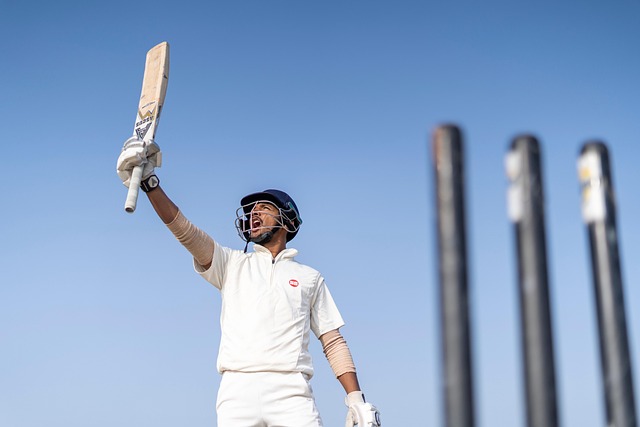Cricket fitness for bowlers focuses on strength, agility, and endurance using data visualization tools to track progress. Training includes targeted exercises for upper body, core, and cardiovascular health, with agility drills enhancing speed and control. Flexibility routines prevent injuries, improving performance and team dynamics in matches. A holistic approach combines modern coaching, functional movements, and sponsorship opportunities within the sport.
In the fast-paced world of cricket, bowlers’ performance is a key determinant of victory. Crafting a tailored fitness training plan is essential to optimize their unique demands. This comprehensive guide explores cricket-specific fitness routines designed to elevate bowling skills. From strengthening upper bodies and cores to enhancing agility and cardiovascular endurance, these strategies help athletes achieve peak condition. Additionally, flexibility and mobility exercises are emphasized for injury prevention, ensuring bowlers can consistently deliver their best on the field.
- Understanding Cricket-Specific Fitness for Bowlers
- Strength Training for Bowlers' Upper Body and Core
- Agility Drills to Enhance Bowling Speed and Control
- Cardiovascular Exercise for Stamina and Endurance
- Flexibility and Mobility Routines for Injury Prevention
Understanding Cricket-Specific Fitness for Bowlers

In cricket, understanding fitness goes beyond general athletic prowess. It involves recognizing and cultivating skills specific to the sport’s unique demands. Bowlers, in particular, require a blend of strength, agility, endurance, and precision to perform at their best on the field. Cricket-specific fitness training plans are designed to cater to these precise needs, ensuring bowlers can consistently deliver accurate and powerful deliveries throughout matches that often span several days.
Cricket data visualization can play a crucial role in understanding these demands and tracking progress. By analyzing performance metrics, coaches and athletes can identify areas for improvement, whether it’s refining technique to reduce strain on specific muscles or enhancing cardiovascular fitness to sustain intensity over longer durations. This data-driven approach, coupled with proper rest and recovery strategies, is key to preventing cricket injuries—a significant concern among bowlers. Remember that, while aiming for peak performance, ensuring long-term sustainability and minimizing the risk of injury should be top priorities. Give us a call at cricket technology innovations for more insights tailored to your needs.
Strength Training for Bowlers' Upper Body and Core

Cricket fitness training plans for bowlers place significant emphasis on upper body and core strength to enhance performance on the field. Effective coaching methods for youth cricket involve incorporating exercises that build robust shoulders, arms, and back muscles, crucial for delivering accurate and fast deliveries. The right training regimen can significantly impact a bowler’s ability to maintain a consistent rhythm and generate maximum pace, as evidenced by cricket statistics analysis.
Apart from traditional strength training techniques, modern coaching strategies also emphasize functional movements that mimic bowling actions. This approach helps bowlers develop a strong foundation in their core muscles, which are vital for stability and balance while delivering the ball. By focusing on both strength and agility, these training plans prepare bowlers to face the rigorous demands of professional cricket and open up various career paths within the sport, including opportunities with leading cricket merchandise and apparel brands or even crowdsourcing data initiatives. To gain expert guidance tailored to your needs, give us a call at cricket career paths.
Agility Drills to Enhance Bowling Speed and Control

In cricket, agility drills are an essential component of any bowler’s training regimen, designed to enhance both bowling speed and control. These exercises focus on quick direction changes, footwork, and overall body coordination, which are vital for achieving high-performance deliveries. By incorporating dynamic stretching, cone drills, and shuttle runs into their fitness plans, bowlers can significantly improve their agility levels. For instance, setting up cones in a zigzag pattern allows players to navigate through them swiftly, mimicking the on-field movements required during a match. This not only increases speed but also sharpens reaction times, enabling bowlers to deliver accurate, swift pitches under pressure.
Agility training should be tailored to mimic the specific actions of bowling—the run-up, delivery stride, and follow-through. Incorporating these drills into a well-rounded fitness routine has added benefits for cricket fans who witness the result in international cricket tournaments. It enhances the overall athletic ability of bowlers, allowing them to maintain consistent performance throughout the game. Moreover, regular practice in these areas can lead to better run scoring strategies and improved control over the ball, making it an invaluable investment in any cricketer’s skill set and a key element of cricket sponsorship value propositions.
Cardiovascular Exercise for Stamina and Endurance

Cricket fitness training for bowlers should incorporate cardiovascular exercises to build stamina and endurance, crucial aspects for maintaining performance throughout long matches. These exercises help in enhancing heart health and increasing oxygen uptake, enabling bowlers to sustain high-intensity bowling sessions with minimal rest. Activities such as sprinting, interval training, and even cycling can significantly improve a bowler’s aerobic capacity, ensuring they have the energy to bowl consistently at their best level for extended periods.
Beyond individual performance, incorporating cardiovascular fitness into training plans also supports team dynamics in cricket. Players who exhibit higher levels of endurance contribute to more successful fieldings and batting strategies, ultimately bolstering the overall team performance. This aspect is often overlooked but plays a significant role in the sport’s dynamic nature, especially when navigating the strategic nuances of cricket trading strategies or analyzing cricket statistics for better decision-making. Moreover, the stamina gained through cardiovascular exercises can translate into better recovery times between matches, making bowlers more valuable assets at international cricket tournaments where they can consistently represent their teams with peak performance.
Flexibility and Mobility Routines for Injury Prevention

Incorporating flexibility and mobility routines into your cricket fitness training is vital for bowlers aiming to perform at their best and stay injury-free during the intense demands of international cricket tournaments or even local club games. The rule of cricket dictates that bowlers must possess a wide range of motion, from their wrist action to their leg strength. A tailored stretching program can significantly reduce the risk of muscle strains, tears, and other common bowling injuries.
These exercises should focus on dynamic stretches to warm up muscles and connective tissues before training or matches, as well as static holds to improve long-term flexibility. Incorporating yoga poses, Pilates movements, and specific cricket-focused drills can enhance mobility in the shoulders, hips, and core—crucial areas for a bowler’s action. By prioritizing flexibility, bowlers can maintain proper form during each delivery, potentially leading to improved performance metrics as analyzed by cricket match analysis tools. Visit us at cricket technology innovations anytime for more tailored training advice.
Cricket fitness training plans for bowlers must incorporate diverse components, including strength training for upper body and core, agility drills to enhance speed and control, cardiovascular exercises for stamina, and flexibility routines for injury prevention. By integrating these elements into their regimens, bowlers can achieve peak performance, maintain endurance throughout matches, and reduce the risk of injuries, ultimately elevating their game in the competitive world of cricket.
